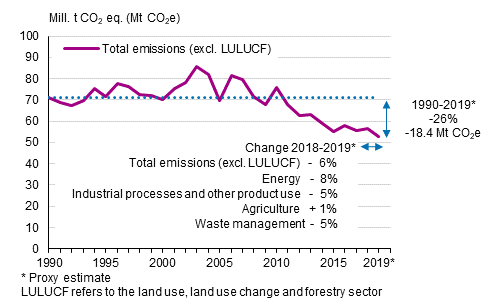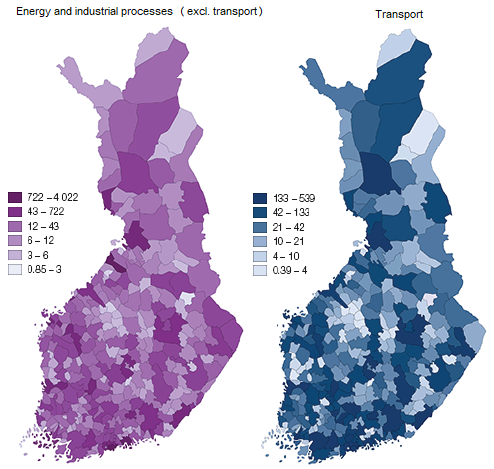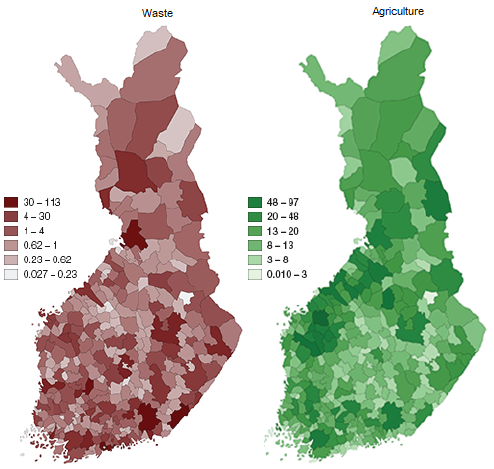Published: 28 May 2020
Greenhouse gas emissions record low
According to Statistics Finland’s instant preliminary data, the total emissions of greenhouse gases in 2019 corresponded with 52.8 million tonnes of carbon dioxide (CO2 eq.). Emissions have fallen by 26 per cent from the comparison year 1990 and by 38 per cent from 2003, when emissions were at their highest during the 1990 to 2019 time series. Compared with the previous year, emissions decreased by six per cent. The fall in emissions was most influenced by the decreased use of coal and peat. Emissions not included in the EU Emissions Trading System fell by two per cent but exceeded the annual emission allocations set by the EU by 0.2 million tonnes of CO2 equivalent. In the instant preliminary data, the emissions and removals of the latest year are produced at a less detailed level than data for previous years.
Finland's greenhouse gas emissions without the LULUCF sector in 1990 to 2019 and changes in emissions compared to 1990 and 2018

Statistics Finland releases instant preliminary data on greenhouse gas emissions of the previous year by sector and broken down between emissions included in the EU Emissions Trading System (ETS) and not included in the EU ETS. More information on greenhouse gas emissions, their development and factors affecting the development, as well as the fulfilment of international obligations can be found in Statistics Finland's report on Finland's greenhouse gas emissions in 1990 to 2019 (only in Finnish) and in the review of this release (only in Finnish).
According to the instant preliminary data, total emissions (excl. LULUCF) decreased by six per cent in 2019 (3.6 million tonnes of CO2 eq.) compared to the previous year. In the energy sector, emissions fell by eight per cent (3.3 tonnes of CO2 eq.) and the emissions from industrial processes and product use by five per cent (0.3 million tonnes of CO2 equivalent). In the energy sector, the fall in emissions was most affected by the decreased consumption of coal and peat. Emissions from agriculture grew by one per cent (0.1 million tonnes of CO2 eq.) and emissions in the waste sector fell by five per cent (0.1 million tonnes of CO2 eq.) from 2018 to 2019. According to the instant preliminary data, the net sink i.e. the sum of emissions and removals of the land use, land-use change and forestry (LULUCF) sector was -17.4 million tonnes of CO2 eq. in 2019, or 70 per cent higher than in the year before. The emissions and removals of this sector are usually not included in total emissions.
Emissions not included in the EU ETS are calculated as the difference between the total emissions and verified emissions in the EU ETS, excluding CO2 emissions from domestic civil aviation as they are estimated in the inventory. The data on the verified emissions in the EU ETS are published by the Energy Authority. Annual emission allocations for the years 2013 to 2020 have been defined in the EU's Effort Sharing Decision for emissions not included in the ETS. Although emissions have decreased in 2018 and 2019 compared to previous years, the target path is exceeded in these years as well as in 2016. However, these could be compensated for with the emissions allocations not used in 2013 to 2015 and 2017.
Greenhouse gas emissions and removals by sector broken down between emissions included in the EU Emissions Trading System (ETS) and not included in the EU ETS in 2013 to 2019
| 2013 | 2014 | 2015 | 2016 | 2017 | 2018 | 2019 1) | Change, 2018- 2019 |
|||
| million t CO2 eq. | % | |||||||||
| Emissions without LULUCF sector 2) | 62.9 | 58.8 | 55.1 | 58.1 | 55.4 | 56.4 | 52.8 | -6 | ||
| CO2-emissions from civil aviation | 0.2 | 0.2 | 0.2 | 0.2 | 0.2 | 0.2 | 0.2 | 10 | ||
| Emissions trading sector emissions 3) | 31.5 | 28.8 | 25.5 | 27.2 | 25.1 | 26.3 | 23.2 | -11 | ||
| Energy sector | 27.6 | 25.1 | 21.6 | 23.0 | 21.1 | 22.2 | 19.4 | -13 | ||
| Industrial processes | 4.0 | 3.7 | 3.9 | 4.2 | 4.0 | 4.0 | 3.9 | -3 | ||
| Difference betweeen the emissions trading registry and the inventory 4) | -0.1 | 0.0 | -0.1 | 0.0 | 0.0 | 0.0 | ||||
| Emissions not included in the EU ETS 5) | 31.2 | 29.8 | 29.5 | 30.7 | 30.1 | 29.9 | 29.3 | -2 | ||
| Energy sector | 20.4 | 19.1 | 18.8 | 20.2 | 19.7 | 19.7 | 19.3 | -2 | ||
| Transport 5) | 11.8 | 10.7 | 10.7 | 11.9 | 11.3 | 11.4 | 11.1 | -3 | ||
| Off-road vehicles and other machinery | 2.6 | 2.5 | 2.4 | 2.3 | 2.4 | 2.5 | 2.5 | -1 | ||
| Other energy sector emissions 6) | 6.0 | 5.9 | 5.7 | 6.0 | 6.0 | 5.8 | 5.7 | -1 | ||
| Industrial processes and products use | 1.9 | 1.9 | 1.9 | 1.8 | 1.8 | 1.8 | 1.6 | -10 | ||
| Industrial processes (excl. F-gases) 7) | 0.5 | 0.5 | 0.5 | 0.5 | 0.6 | 0.6 | 0.4 | -28 | ||
| Consumption of F-gases 7) | 1.4 | 1.4 | 1.4 | 1.3 | 1.2 | 1.2 | 1.2 | -1 | ||
| Agriculture | 6.6 | 6.6 | 6.6 | 6.7 | 6.6 | 6.6 | 6.6 | 1 | ||
| Waste management | 2.3 | 2.2 | 2.1 | 2.0 | 1.9 | 1.8 | 1.7 | -5 | ||
| Indirect CO2 emissions | 0.1 | 0.1 | 0.1 | 0.1 | 0.1 | 0.1 | 0.1 | 0 | ||
| Difference between the emissions trading registry and the inventory 4) | 0.1 | 0.0 | 0.1 | 0.0 | 0.0 | 0.0 | ||||
| LULUCF sector 2) | -19.0 | -21.3 | -18.9 | -16.8 | -17.2 | -10.3 | -17.4 | 70 | ||
2) LULUCF refers to the land use, land-use change and forestry sector. The sector does not come under the scope of the Emissions Trading System or the reduction targets under the Effort Sharing Decision
3) Source: Energy Authority
4) The divergence caused by the methodological and definitional differences in total emissions in the emissions trading sector between the data of the Energy Authority and the Greenhouse Gas Inventory
5) Excluding CO2 emission from domestic civil aviation according to the inventory.
6) Includes emissions from e.g. residential and commercial heating, waste incineration and fuel use in manufacturing industy
7) F-gases refer to fluorinated greenhouse gases (HFC, PFC compounds, SF6 and NF3)
In the instant preliminary data, the emissions and removals for 2019 are calculated at a less detailed level than data for previous years. The 2019 emissions will become revised as all data used in the calculation are completed. Preliminary data of the statistics on greenhouse gases will be released in December 2020 and official data in March 2021. More detailed information on the calculation methods of instant preliminary data can be found in the review of this release (only in Finnish) and in Appendix 3 of the report on Finland's greenhouse gas emissions in 1990 to 2019 (only in Finnish).
.
Regional data on emissions
Statistics Finland's calculations have been made for 2011, 2013, 2015, 2017 and 2018 from the so-called region-based perspective, i.e. emissions have been allocated to their places of origin. The data have been calculated with methods consistent with the national greenhouse gas inventory by allocating emissions to regions on the basis of data on activity by municipality. The data have been separately calculated for the sectors of transport, energy (without transport), industrial processes and product use, agriculture and the waste sector. The calculations exclude the land use, land use change and forestry sector (LULUCF). Statistics Finland publishes numeric data by municipality only on emissions not included in the EU Emissions Trading System for confidentiality reasons. Total emissions and emissions from the Emissions Trading System are published on the level of regions. The emissions data can be found in the database tables .
More detailed information on the calculation methods of regional data on emissions can be found in the methodological description (only in Finnish) and in Appendix 4 of the report on Finland's greenhouse gas emissions in 1990 to 2019 (only in Finnish).
Greenhouse gas emissions from the energy sector, industrial processes and product use and transport in Finland by municipality in 2018 (1,000 t CO2 eq.)

Greenhouse gas emissions from the waste sector and agriculture in Finland by municipality in 2018 (1,000 t CO2 eq.)

Source: Greenhouse gas inventory unit. Statistics Finland
Inquiries: Pia Forsell 029 551 2937, Päivi Lindh 029 551 3778, Sini Niinistö (LULUCF) 029 551 2954, kasvihuonekaasut@stat.fi
Director in charge: Jan Nokkala
Publication in pdf-format (567.6 kB)
- Tables
-
Tables in databases
Pick the data you need into tables, view the data as graphs, or download the data for your use.
- Revisions in these statistics
-
- Revisions in these statistics (28.5.2020)
Updated 28.5.2020
Official Statistics of Finland (OSF):
Greenhouse gases [e-publication].
ISSN=1797-6065. 2019. Helsinki: Statistics Finland [referred: 20.12.2025].
Access method: http://stat.fi/til/khki/2019/khki_2019_2020-05-28_tie_001_en.html

